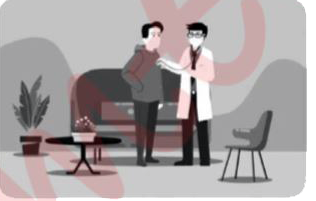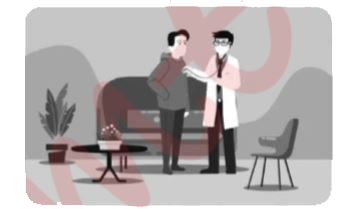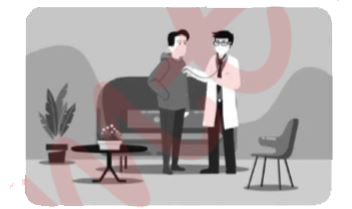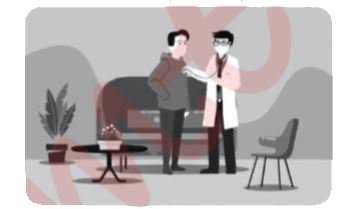A doctor claims of 60% of the patients he examines are allergic to some type of weed. What is the probability that (i) exactly 3 of his next 4 patients are allergic to weeds? (ii) none of his next 4 patients is allergic to weeds?
To solve the problem, we will use the binomial probability formula. The binomial probability formula is given by:
P(X=k)=(nk)pk(1−p)n−k
Where:
- n = number of trials (in this case, patients)
- k = number of successes (patients allergic to weeds)
- p = probability of success on an individual trial
- (nk) = combination of n items taken k at a time
Given:
- The probability p that a patient is allergic to weeds = 60% = 0.6
- The probability that a patient is not allergic to weeds = 1−p=0.4
- The number of patients n=4
Part (i): Probability that exactly 3 of his next 4 patients are allergic to weeds
1. Identify the values:
- n=4
- k=3
- p=0.6
2. Calculate the combination:
(43)=4!3!(4−3)!=4×3!3!×1!=4
3. Calculate pk:
p3=(0.6)3=0.216
4. Calculate (1−p)n−k:
(1−p)4−3=(0.4)1=0.4
5. Combine all parts to find the probability:
P(X=3)=(43)(0.6)3(0.4)1=4×0.216×0.4
P(X=3)=4×0.0864=0.3456
Part (ii): Probability that none of his next 4 patients is allergic to weeds
1. Identify the values:
- n=4
- k=0
- p=0.6
2. Calculate the combination:
(40)=1
3. Calculate pk:
p0=(0.6)0=1
4. Calculate (1−p)n−k:
(1−p)4−0=(0.4)4=0.0256
5. Combine all parts to find the probability:
P(X=0)=(40)(0.6)0(0.4)4=1×1×0.0256=0.0256
Final Answers:
(i) The probability that exactly 3 of his next 4 patients are allergic to weeds is 0.3456.
(ii) The probability that none of his next 4 patients is allergic to weeds is 0.0256.
- n = number of trials (in this case, patients)
- k = number of successes (patients allergic to weeds)
- p = probability of success on an individual trial
- (nk) = combination of n items taken k at a time
- The probability p that a patient is allergic to weeds = 60% = 0.6
- The probability that a patient is not allergic to weeds = 1−p=0.4
- The number of patients n=4
- n=4
- k=3
- p=0.6
(43)=4!3!(4−3)!=4×3!3!×1!=4
p3=(0.6)3=0.216
(1−p)4−3=(0.4)1=0.4
P(X=3)=(43)(0.6)3(0.4)1=4×0.216×0.4
P(X=3)=4×0.0864=0.3456
- n=4
- k=0
- p=0.6
(40)=1
p0=(0.6)0=1
(1−p)4−0=(0.4)4=0.0256
P(X=0)=(40)(0.6)0(0.4)4=1×1×0.0256=0.0256
(i) The probability that exactly 3 of his next 4 patients are allergic to weeds is 0.3456.
Topper's Solved these Questions
Similar Questions
Following are the ages (in years) of 360 patients , getting medical treatment in a hospital :

One of the patients is selected at random
What is the probability that his age is
(i) 30 years or more but less than 40 years ?
(ii) 50 years or more but less than 70 years ?
(iii) 10 years or more but less than 40 years ?
(iv) 10 years or more ?
(v) less than 10 years ?View SolutionA doctor is to visit a patient. From the past experience, it is known that the probabilities that he will come by train, bus , scooter or by other means of transportation are respectiely 310,15,110 or 25. The probabilities that he will be late are 14,13 and 112 if he comes by train, bus and scooter respectively but if he comes by other means of transport, then he will not be late. If the arrives late, find the probability that he comes by train.
View Solution
Knowledge Check
- Question 1 - Select One
Zuckerberg ,my facebook friend, recently returned from his honeymoon trip to three European cities-Paris, Milan and Zurich, where he had clicked some photos before uploading them on facebook in three different folders naming them on the cities he had visited . The folders Paris, Milan and Zurich have3,4 and 5 photos, respectively. He asks his six year old niece Olivia Bee that if she could download these photos and edit them using the Instagram and put them back but only one photo in each folder. Within no time she edits all the photos in each folder. Within no time she edits all the photos and uploads back quickly one photo in each folder. What's the probability that she uploads at least two photos of the same city and no folder has the photo uploaded back to its original folder, after editing?
A1/11B1/12C3/11D1/3 - Question 2 - Select One
A doctor is to visit a patient. From the past experience, it is known that the probabilities that the he will come by cab, metro, bike or by other means of transport are respectively 0.3, 0.2, 0.1 and 0.4. The probabilities that the he will be late are 0.25, 0.3, 0.35 and 0.1 if he vomes by cab, metro,bike and other means of transport respectively.

Based on the above information, answer the following questions.
When the doctor arrives late, what is the probability that he comes by cab ?A421B17C514D221 - Question 3 - Select One
A doctor is to visit a patient. From the past experience, it is known that the probabilities that the he will come by cab, metro, bike or by other means of transport are respectively 0.3, 0.2, 0.1 and 0.4. The probabilities that the he will be late are 0.25, 0.3, 0.35 and 0.1 if he vomes by cab, metro,bike and other means of transport respectively.

Based on the above information, answer the following questions.
When the doctor arrives late, what is the probability that he comes by other means of transport ?A67B514C421D27
A shopkepper sells three types of flower seeds A1,A2andA3. They are sold as mixture, where the proportion are 4 : 4 : 2, respectively. The germination rates of the three types of seeds 45%, 60% and 35%. Calculate the probability
(i) of a randomly chosen seed to germinate.
(ii) that it will not germinate given that the seed is of type A3.
(iii) that it is of the type A2 given that a randomly chosen seed does bot germinateView SolutionA doctor is to visit a patient. From the past experience, it is known that the probabilities that the he will come by cab, metro, bike or by other means of transport are respectively 0.3, 0.2, 0.1 and 0.4. The probabilities that the he will be late are 0.25, 0.3, 0.35 and 0.1 if he vomes by cab, metro,bike and other means of transport respectively.

Based on the above information, answer the following questions.
When the doctor arrives late, what is the probability that he comes by bike ?View SolutionA doctor is to visit a patient. From the past experience, it is known that the probabilities that the he will come by cab, metro, bike or by other means of transport are respectively 0.3, 0.2, 0.1 and 0.4. The probabilities that the he will be late are 0.25, 0.3, 0.35 and 0.1 if he vomes by cab, metro,bike and other means of transport respectively.

Based on the above information, answer the following questions.
When the doctor arrives late, what is the probability that he comes by metro ?View SolutionA doctor is to visit a patient. From the past experience, it is known that the probabilities that the he will come by cab, metro, bike or by other means of transport are respectively 0.3, 0.2, 0.1 and 0.4. The probabilities that the he will be late are 0.25, 0.3, 0.35 and 0.1 if he vomes by cab, metro,bike and other means of transport respectively.

Based on the above information, answer the following questions.
What is the probability that the doctor is late by any means ?View SolutionConsider the following statements
I : An experiment succeeds twice as often as it fails. Then, the probability that in the next six trials, there will be atleast 4 successes is 319(23)4
II : The number of times must a man toss a fair coin so that the probability of having atleast one head is more than 90% is 4 or mor than 4.View Solution

